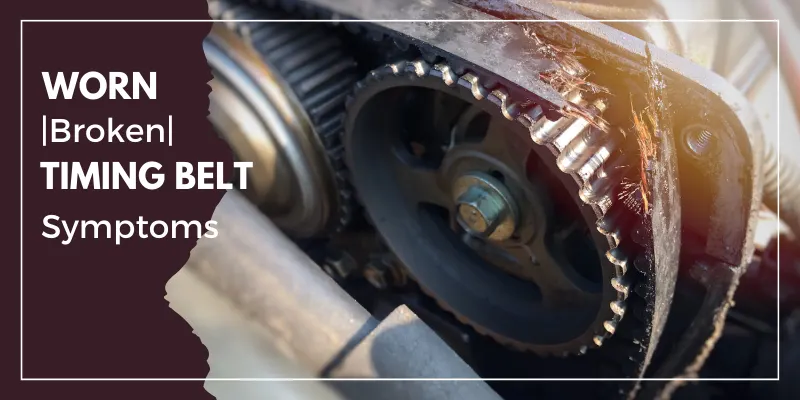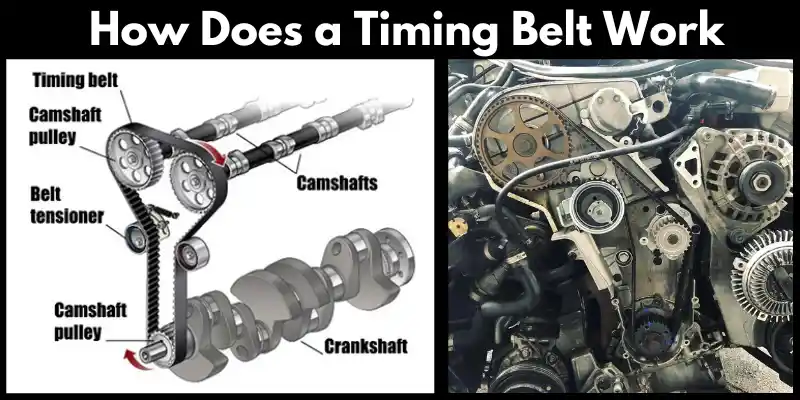Sign of Worn or Failing timing belt
Updated: 11 Jul 2024
79

When it comes to car maintenance, one of the most critical components to watch is the timing belt going bad. It synchronizes different mechanical systems together. A worn timing belt can lead to serious engine problems due to an imbalance in the open-close mechanism, potentially leaving you stranded on the side of the road. Understanding the symptoms of a worn timing belt can help you prevent catastrophic damage and costly repairs.
In this article, we’ll explore everything you need to know about timing belt wear and what signs to watch out for.
Common Signs (Symptoms) of a Worn (Bad)Timing Belt
A worn timing belt can exhibit several symptoms that warn the driver it’s time for a replacement. Here are the most common signs to watch out for:
- Poor Engine Performance
- Ticking Noise from the Engine
- Exhaust Smoke
- Check Engine Light
- Engine Doesn’t Turn Over (get start)
- Rough Idling
- Visible Wear and Tear
Let’s delve into each of these symptoms in more detail.
1. Poor Engine Performance
Low Performance is a strong symptom of a failing timing belt. Because the timing belt runs all systems in sync, any issue in the timing belt leads to worse performance. If the timing belt wears with usage or gets old, the engine gets misfired. The timing belt can slip on the camshaft, causing irregular opening and closing as the engine operates normally. This is a pre-system warning before engine damage occurs.
2. Ticking Noise from the Engine
One of the earliest signs of a worn timing belt is a ticking noise from the engine. This noise is caused by the belt becoming loose or wearing down, which affects the synchronization of the engine’s components. The timing belts attach pulleys to the crankshaft and camshaft; the crankshaft passes power to connecting rods, while the camshaft is responsible for operating valves on cylinder heads. Disturbance in this process or defective timing belts create a ticking sound. It’s essential to have your timing belt inspected by a professional mechanic.
3. Exhaust Smoke
If you feel your car engine has to work harder than normal while driving and notice extra exhaust smoke, it means that your car is operating under pressure and needs immediate attention.
Bad timing allows more air to enter the system, which imbalances the air-fuel ratio and releases more exhaust smoke.
4. Check Engine Light
If the Check Engine light illuminates on the Vehicle dashboard, it means there is a malfunction in the engine or vital Parts, such as the camshaft or crankshaft timing. If you feel other symptoms along with the check engine light, it’s a strong indicator that there is a timing belt issue. If the check engine light flashes, it warns you to stop driving. You can try to check by connecting an OBDII scanner to see the fault code; otherwise, consult a local mechanic.
5. Engine Doesn’t Turn Over (get start)
Whenever the timing belt is not replaced on time and breaks completely, the engine will not start(turn over). While the starter motor is attempting to engage, no ignition will occur, and there will probably be no attachment between the crankshaft and camshaft due to the broken timing belt.
Unfortunately, if the timing belt breaks while driving, valves, rocker arms, and push rods will suffer additional damage.
If the engine dies (shuts down) during driving and cannot start again, you will hear that the starter is spinning faster.
After finding these signs, don’t try to drive the car. Contact a professional mechanic or use car recovery services to take it to the garage.
6. Rough Idling
Rough idling is another symptom of a worn timing belt. When the timing belt is damaged or worn, it can cause the engine to idle roughly, leading to vibrations and unusual noises. This issue can escalate over time, affecting the overall performance of your vehicle.
7. Visible Wear and Tear
Sometimes, you can visually inspect the timing belt for signs of wear and tear. Look for cracks, fraying, or glazing on the belt’s surface. If you notice any of these signs, it indicates that the timing belt needs to be replaced.
Timing Belt Location
The timing belt is made of rubber and is usually found on one side of the engine inside the timing cover. If the cover is heavy-duty metal, it means your car uses a timing chain instead of a belt.
In both cases, it’s an essential component to operate the engine normally.
What is a Timing Belt, and How Does a Timing Belt Work?

In-vehicle engine timing belts play a crucial role. They link the crankshaft and camshaft. The crankshaft is responsible for regulating the positioning of the engine’s pistons, and the camshaft opens and closes the engine valves.
As the crankshaft turns, the timing belt moves the camshaft in sync, ensuring the valves open and close in coordination with the movement of the pistons. This synchronization is vital for proper engine operation and to prevent the pistons from colliding with the valves, which can cause significant damage.
The timing belt coordinates several other moving parts simultaneously, such as the oil pump and water pump.
A toothed timing belt is used here, which interlocks with cogwheels of other connected components.
How to Diagnose Timing Belt Problems
Diagnosing timing belt problems involves a combination of visual inspections and listening for unusual noises. Mechanics may also use specialized tools to check the belt’s tension and alignment. If any issues are detected, it’s crucial to replace the timing belt to prevent further damage to the engine.
Preventing Timing Belt Issues
Preventing timing belt issues is all about regular maintenance and timely replacements. Here are some tips to keep your timing belt in good condition:
- Follow Manufacturer’s Recommendations: Replace the timing belt according to your vehicle manufacturer’s recommended schedule, usually between 60,000 and 100,000 miles.
- Regular Inspections: Inspect your timing belt regularly for signs of wear and tear.
- Listen for Noises: Pay attention to any unusual noises from the engine, such as ticking or rattling.
- Address Issues Promptly: If you notice any symptoms of a worn timing belt, have it inspected and replaced as soon as possible.
Timing Belt When To Replace
Replacing your timing belt at the recommended intervals is crucial to prevent engine damage. Most manufacturers recommend replacing the timing belt every 60,000 to 100,000 miles. However, if you notice any symptoms of a worn timing belt, you must replace it immediately to avoid further issues.
Timing Belt Replacement Cost
The time belt replacement costs, in normal cases, are around $200 up to $1000. However, belts and related components cost between $40 and $500. Refer to the manufacturer’s catalogue. The labour cost is more dependent on how long it takes to finish the task because it’s inside, and many extra parts need to be unscrewed for a successful job, so just consider $200 to $500.
You may put a new water pump during the replacement of the timing belt due to its location.
Overall replacement cost depends on the Vehicle model. Whether it’s a small car or a luxurious one, it needs an expert mechanic, expensive components, and a timing belt warranty, which increases your bill payments.
If you do not have complete mechanical knowledge, such as how length size can be taken from a chart or calculator, it’s not recommended to replace it yourself. It needs tensioner tools. Although it’s a crucial part and will lead to engine failure, it’s better to check when you find any symptoms before it’s too late!
Conclusion
The timing belt is vital to your car’s engine, ensuring all parts work in perfect harmony. By understanding the symptoms of a worn timing belt, you can take proactive steps to maintain your vehicle’s performance and prevent costly repairs. Regular inspections, timely replacements, and addressing any issues promptly are key to keeping your timing belt in good condition. Don’t ignore the signs—your engine’s health depends on it!
FAQs
Is there any warning before the timing belt breaks?
Timing belts usually break without any warning and can damage your engine. In some cases, if there is something wrong with camshaft timing, there is a check engine light on the vehicle dashboard. In all remaining cases, it will break and seize the engine. Therefore, it’s good to replace the suspected timing belt before it breaks.
What happens if a timing belt breaks while driving? Can you drive with a broken timing belt?
If a timing belt breaks while driving, it can cause severe engine damage. The pistons and valves can collide, leading to bent valves, damaged pistons, and potentially a ruined engine. Replacing the timing belt before it fails is crucial to avoid such catastrophic damage.
Can I drive with a worn timing belt?
Driving with a worn timing belt is risky. A worn belt can break or slip, leading to engine misfires, loss of power, and potentially severe engine damage. It’s best to replace a worn timing belt as soon as possible to ensure your vehicle’s reliability and safety.
How much does it cost to replace a timing belt?
The cost of replacing a timing belt varies depending on your car’s make and model. You can expect to pay between $500 and $1,000 for parts and labour. Some high-end vehicles might have higher costs due to more complex engine designs.
How often should a timing belt be replaced?
According to the manufacturer’s recommendations, timing belts should be replaced every 60,000 to 100,000 miles. However, if you notice any symptoms of a worn timing belt, you must replace it immediately to avoid further issues.
Can I check my timing belt myself?
While you can visually inspect the timing belt for signs of wear and tear, such as cracks or fraying, a professional mechanic should perform a thorough check. They have the tools and expertise to accurately assess the belt’s condition and determine if it needs replacing.
Please Write Your Comments